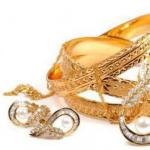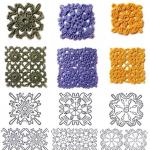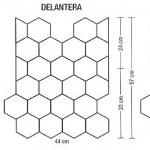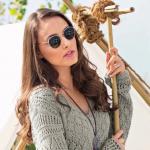Development of mathematical concepts 2nd junior group. Lesson notes for the second junior group of femp “visiting the bunny”
GCD for FEMP in 2 younger group
Prepared and conducted by teacher N.P. Bulbas.
Subject:“Let’s count all the toys”
Goals:
Practice composing a group of objects and the ability to select one from a group of objects.
- To consolidate knowledge of the concepts: one, many, few.
Introduce the geometric figure in a circle.
Practice correctly naming the geometric figure circle and the general concept of “toy”.
Demonstration equipment: toys - bear, hare, car; handout: small toys three types - one, several, many, (cubes, pyramids, ball) multi-colored circles according to the number of children.
Progress of the lesson
Educator - Guys, today I brought toys to the group, but for some reason they are nowhere to be found, only a letter is on the table. Let's read and find out what is written in it.
Letter: An evil wizard writes to you who took your toys, if you
If you guess riddles about them, I will return them to you.
Educator - Well, guys, shall we solve riddles?
Children - Yes.
Educator - Listen carefully.
Educator - A funny animal made of plush.
There are paws, there are ears.
Give some honey to the beast
And make him a den.
Children - Mishka.
Educator - Drinks gasoline like milk,
Can run far.
Carries goods and people.
You know her, of course?
Children - Machine.
Educator - A ball of fluff,
Long ear.
Jumps deftly
Loves carrots.
Children - Hare
(Toys Teddy Bear, Bunny and Car appear to the accompaniment of fairy-tale music)
Educator - I’m very glad that you guessed all the riddles correctly.
Educator - Guys, what can you call a bear, a bunny and a car in one word?
Children are toys.

Educator - Correct, what are toys for?
Children - To play with them.
Educator - Guys, the toys brought you gifts,
toys small toys
Teacher - Kirill, how many balls did the bear bring?
Kirill - One.
Teacher - Nastya, how many cubes did the car bring?
Nastya - A lot.

Teacher - Vika, how many pyramids did the bunny bring?
Vika - Two.
Educator - Is this a lot or a little?
Vika - A little, a little.

Educator - Tasks:
Have one of the children take the ball and put it on the table. How many balls does the bear have and how many are on the table?
Children - The bear doesn’t have balls. There is one ball on the table.
Educator - Nastya take the cubes and put them on the table.
Educator - Nastya, how many cubes did you put on the table?
Nastya - I bet five dice.
Educator - How much is left in the car?
Nastya - There is not a single cube left in the car.
Teacher - Bunny offers Rodion to take
pyramids, place them on the table near the car.
Teacher - Rodion, how many pyramids did the bunny give you?
Rodion - Two pyramids.

Educator - Well done guys. You all completed the task correctly.
Physical education minute.
We are funny nesting dolls, Clap your hands.
Okay, okay.
We have boots on our feet, Stompers.
Okay, okay.
In our colorful sundresses, Spinning, hands on the belt.
Okay, okay.
We look like sisters
Okay, okay.
Educator - I have interesting figures
different colors, look. 
Educator - What do they look like?
Children - On a circle, a wheel, a sun.
Educator - Correct. I'll tell you about the geometric figure of a circle. (I show its circumference with a gesture)
Educator - I suggest you take your small circles and also show how round they are, roll them in your hands, admire them.

Educator - Guys, show me who has the circles Green colour. (Children raise their mugs)
Educator - Well done, guys, I’m glad that you know the color green.
What else does the green circle look like?
Children - At a green traffic light.
Educator - Correct. 
Educator - Let's look at our car.
Tell me, does the car have parts that look like a circle?
Children - Yes. These are wheels. 
Educator - Indeed, look how they spin and the car can drive along the road.
Educator - Guys, I hear that Mishka and Bunny are talking to each other about something. They want to tell me something.
Educator - Guys, our toys want to apologize; it’s time for them to visit another group. We all enjoyed counting and playing with the circle figure, but our activity is also coming to an end.
Let's say goodbye to toys. Let's tell them to see you again.
Children - Goodbye.
(The toys drive away in the car to cheerful music)
Goals:
- Consolidate knowledge about geometric shapes ah, answer the question “how much?” ” in words one, many, none.
- Reinforce the concepts of “big” and “small” and compare and select objects by size.
- Develop orientation in space and on yourself.
Educational objectives
- continue to teach children to listen and understand asked question and answer it clearly;
- consolidate and generalize children’s knowledge about the number of objects (one, many, none), the size of objects (large-small);
- consolidate the ability to distinguish and name primary colors: red, blue, yellow, green.
Developmental tasks:
- Develop auditory and visual attention, imagination.
- Develop speech and observation skills. Expand and activate children's vocabulary.
Educational tasks:
Cultivate kindness and responsiveness.
Equipment and materials:
Equipment: soft toy A mouse from a fairy tale by S. Marshak. Large and small cardboard frames in the form of a lock and a set of inserts - multi-colored keys. Large and small multi-colored circles. Two dolls, clothes - different sizes.
Progress of the lesson
1. Introduction to the game situation
Introductions fairy tale hero a smart mouse from Marshak’s fairy tale “The Tale of a Smart Mouse”
Guys, a guest will come to us today, I’ll tell you a riddle, and you guess who he is?
Small stature
A long tail
Collects crumbs
Hiding from the cat.
The mouse says that he came to the children because he knows that they are as smart as he is.
2. Main part.
Didactic game “Pick up the key to the lock (on the carpet)
Educator:
Guys, our Mouse is sad. Little mouse, why are you so sad?
Guys, he says that he lost the key to the magic door. It must be found, picked up. Let's look at them: - Egor, what are the keys in size (larger and small), and what are the locks? What color are the keys?
Children name colors (blue, yellow, red, green)
Look what kind of castle this is? (big)
What kind of castle is this? (small)
Guys, what are the keys? (small, identical, many),
Did you find the big keys?
That's right, not a single big key
The red key goes to which lock, and the green one?
So we helped the Mouse open the doors: a small red key came to the big lock, and a small key came to the small lock. The keys are all the same. The mouse is happy, he smiles.
Finger game "Finger-boy"
Guys, the Mouse says that in his fairy tale even the fingers on children’s hands become magical, and he offers to play with the fingers:
Thumb-boy, where have you been?
I went to the forest with this brother,
I cooked cabbage soup with this brother,
I ate porridge with this brother,
I sang songs with this brother. (the thumb is alternately connected to the rest in accordance with the text) 2-3 times.
Game-activity “Two dolls”
Guys, the dolls Dasha and Masha came to visit us. They heard that the children helped the Mouse open the locks. They also ask you to help them choose a coat that fits. Shall we help you guys?
That's right, guys, the Dasha doll is taller than the Masha doll. This means that Dasha’s clothes should be large, and Masha’s clothes should be small.
What kind of clothes does Dasha wear? What about Masha?
I suggest, guys, to make a gift for the Mouse - a rug. Select small circles of different colors and place them on the larger circle.
What circles and what color did Sonya choose, and Valeria, Alice?
What color is our big circle Rodion? How many big circles do we have?
How many small Elisha circles do we have?
How many small circles do we have left?
That's right, not a single one.
Guys, the mouse invites us to play the game “Run to Me.” The mouse wants to see how attentive you are and will stand in different places. You must see where the Mouse is standing and run there.
Did you enjoy playing with the Mouse?
Guys, let's say goodbye to the Mouse.
What game did Matvey and Sonya like?
I also liked how you helped the Mouse.
For example: “How many buttons are on the red stripe? How many buttons are on the blue stripe? Now tell me how many buttons are on the blue stripe and how many are on the red one.” The child is led to reflect the connections: “There is one button on the red stripe, and there are many buttons on the blue stripe.” The teacher gives a sample answer or begins it, and the child finishes it. To understand the method of action, children are asked to say during the work what and how they are doing, and when the action has already been mastered, before starting work, express what and how to do. “What should you do to find out which board is wider? How do you know if there are enough pencils for everyone?” This is how connections are established between the properties of things and the actions through which they are revealed. In this case, the teacher uses only those words whose meaning is clear to the children.
Self-analysis of nodes on femp in the 2nd junior group “in search of Ivanushka”
Attention
The use of these methods and techniques in the formation of younger children preschool age elementary mathematical representations will allow the teacher to successfully cope with the task and will help children to qualitatively acquire new knowledge and apply it in practice. Literature:
- Vodopyanov, E. N. Formation of initial geometric concepts in preschoolers. / E. N. Vodopyanov. // Doshk. Education, 2000, No. 3.
- Erofeeva, T.I., Pavlova, L.N., Novikova, V.
P. Mathematics for preschoolers: Book. For the teacher of children. garden - M.: Education, 1992.
- M., 2000.
Methodology for conducting classes in the second junior group
Summary of the culminating event for FEMP “In Search of Prizes” in senior group municipal autonomous preschool educational institution combined type Kindergarten "Rodnichok" r. Chishmy municipal district. Abstract of OD on FEMP in preparatory group“In search of the lost planet” OD summary for FEMP in the preparatory group on the topic: “In search of the lost planet.” Goals: Improve the ability to find the place of a number.
Info
Lesson in the senior group on FEMP “Counting within 10. In search of treasure” GOAL: - to improve the ability to count within 10. INTEGRATION OF EDUCATIONAL AREAS: cognitive development, speech development,.
Abstract of the educational activity for FEM "In search of treasures" in the senior group Program content: - Continue to teach children to navigate in space; - Continue to introduce the quantitative composition of numbers.
Notes "mathematics" femp (2nd junior group)
We present to your attention a video recording of a direct educational activities on the formation of elementary mathematical concepts based on the fairy tale “Geese and Swans” in the 2nd junior group “In Search of Ivanushka”. in educational areas: “Cognition”, “Socialization”, “Communication”, “Fiction”, “Health” Direction: cognitive, speech development. Theme of the lesson: “In search of Ivanushka” Children aged 3 to 4 years (2nd junior group). I have set the following goals for myself: Educational: to continue the formation of mental operations (analysis, comparison, generalization, classification); form ideas about the properties of objects: color, shape, size; the ability to identify and explain signs of similarity and difference between objects, to combine them into groups based on common characteristics; consolidate the count to 5; develop the skill of answering questions completely.
3. analysis of the “harmony” program in mathematics in kindergarten
Taking all this into account, I outlined the goal, objectives, content, determined the form of implementation, methods, techniques and means necessary for positive results. Purpose of the lesson: to summarize the knowledge, skills and abilities acquired during the year. I set the following tasks: Educational: continue to form elementary mathematical concepts: - distinguish the shape, color, size of objects and objects; - mastering simple connections and relationships: larger (smaller) in size, the same, larger (smaller) in quantity, the same, identical and different in color and size; - consolidate the ability to compose an image of an object from parts; - ability to navigate in a small space: in front (behind), above (below), right (left).
Developmental: - develop speech and cognitive activity, attention, memory, thinking, intelligence, imagination; development of sensory culture.
Important
Purposeful work on the formation of elementary mathematical concepts begins with the second junior group. It is very important to organize children’s successful perception of the spatial forms of real objects and their quantitative relationships in a given age period, because the further successful development of mathematical concepts in students depends on this. Children are introduced to the elements of mathematical representations on the basis of set theory.
When working with children of primary preschool age, many objects are used, characterized by one common feature that unites these objects. Thus, we develop in children the ability to identify qualitative features of various objects (shape, color, texture).
Analysis of femp in the second junior group
In an effort to warn possible mistakes, he shows all the operating techniques and explains in detail the sequence of actions. His explanations are extremely clear, clear, specific, and given at a pace that is understandable small child. The most complex methods of action are demonstrated 2-3 times, while the teacher draws the children’s attention to new details each time.
Only repeated showing and naming of the same actions in different situations When changing visual material, they allow children to learn methods of action. During the work, it is important not only to point out mistakes to children, but also to find out their reasons. Errors are corrected directly in action with didactic material. The teacher’s explanations are unobtrusive and laconic. Sometimes mistakes are best corrected without explanation.
Didactic games on FEMP in the second junior group Interesting tasks V game form help children learn a lot of new and interesting things. With preschoolers we need to learn through didactic games. Forming elementary mathematical concepts offers a lot didactic games to study the material.
During the summer period, you can consolidate all the knowledge acquired during the academic year. This should be done while playing: “Let’s compare objects” (offer the children 2 toys: high and low). “Who learned to compare stripes? Where is the wide one, where is the narrow one?”; “Which color ran away from us?” (show 5 squares of primary colors, then hide one. They love to guess which color is gone). You can also hide geometric shapes.
There is a very interesting and famous game at all times: “hot and cold” (let them play detective and find a small toy hidden by the teacher).
At the main stage of the NOOD, the following tasks were solved: Tasks: “At the forest edge”, “Three Bears”, “Strawberry for Bears”, “Teremok”, were aimed at appealing to previously accumulated experience, the development of memory, intelligence, knowledge of mathematical concepts, representations about geometric figures. During the lesson, the children were engaged productive activity, which was aimed at the ability to compose an image of an object from parts. (Animal houses). In order to improve the health of children, I used gymnastics (physical education).
The educational activity for 15 minutes was dynamic and provided for a quick change of children's activities, which made it possible to avoid children's fatigue. The children completed all tasks and exercises with pleasure and interest, and were active and inquisitive throughout the entire educational activity. The atmosphere in the class was friendly.
At first school year children are given simple tasks to assemble sets of objects that have only one characteristic that unites them, for example, to collect all the balls from a group of objects with different geometric shapes. Further, the tasks become more complicated; children are asked to create a group of objects characterized by two common characteristics, for example, to assemble a group consisting of red balls. Later, children are taught to form groups of a certain number of objects, united by a common feature or several features, and also to find in two groups a feature that unites or distinguishes these two groups. The main attention in this age period is paid to classes comparing the qualitative characteristics of objects: shape, color, length, width, height. When teaching children of younger groups, a visual and effective method is used.
All parents want their child to be smart and developed. Therefore, many try to teach kids to count and write right away. Teachers do not recommend working with children in this way.
They believe that first a child must master basic mathematical concepts. These are not numbers. First of all, the child must understand: few, many, top, bottom, big, small, etc. Numbers are a small part of mathematics. They should be available to the child no earlier than 4 years old.
Every year the child’s understanding of mathematics expands more and more. Children in the second youngest group are good at learning what shapes, colors, etc. are. Even orientation in space is considered mathematics.
Therefore, FEMP in the second junior group does not provide numbers. Before training, you need to develop a lesson plan for the year. This way, you can be sure that your children will gain all the necessary understanding of mathematics.
Olga Antonova
Lesson on FEMP in the second junior group according to the Federal State Educational Standard
"One figurine, two figurine"
Goals: Consolidate knowledge about geometric shapes, answer the question “how much?” with words one, many, none.
Continue to develop the ability to compose group from individual objects and select one object from it.
Preliminary work: Teach children to pay attention to the shape and color of objects in everyday life.
Examination of one and many objects.
Games: “What does it look like?” "In an even circle"
Program content. Educational objectives
continue to teach children to dialogue with teacher: listen and understand the question asked and answer it clearly;
consolidate and generalize children’s knowledge about the number of objects (one, many, none,
consolidate the ability to distinguish and name the main colors: red, blue, yellow, green;
Developmental tasks:
Develop auditory and visual attention, imagination.
Develop speech, observation, mental activity
Expand and activate children's vocabulary.
Develop logical thinking.
Develop coordination, spatial orientation, enrich the motor experience of children.
Educational tasks:
Cultivate a desire to work;
Cultivate kindness and responsiveness.
Equipment and materials:
Demonstration: soft toy Bear. Large and small cube.
Big and small box
Handout: Large and small cubes according to the number of children. One plate per child. Circles of blue color in sockets for each child.
Location: group(on the carpet and at tables)
Progress of the lesson
1. Introduction to the educational game situation
Guys, a guest will come to us today, but you have to guess who will come to us, I’ll tell you a riddle, and you guess who he is?
The funny beast is made from plush:
There are paws, there are ears.
Give the beast some honey
And make him a den. Who are these guys? (Bear)
That's right, it's a bear, his name is Mishutka.
Let's say hello to him and invite him to play with us.
2. Main part.
1. Game - task "Put the cubes into boxes" (on the carpet)
Educator:
Guys, our Mishutka is sad. Mishutka why are you so sad?
Guys, he says that two boxes of cubes fell apart. Really look at how many cubes there are on our carpet. Let's get them consider: -Alyosha what size are the cubes? (bigger and smaller). What color are the cubes? I ask all children individually.
Children name the colors (blue, yellow, red, green)
Mishutka asks you to help him arrange the cubes into boxes: big cubes in a big box, and small ones in a small box, let's help Mishutka. Look at your cubes. Show me the big cube (show) Show small (show)+ I pin individually
There are demonstrations on the teacher’s table cubes: big and small. The teacher is the first to lay out the boxes, accompanying the actions with speech.
Look what kind of box is this? (large)
What kind of box is this? (small)
Guys, I’ll put the big cube in a large box, and the small one in a small box (the children complete the tasks after the teacher’s explanation, they come up one at a time and put the cubes in the boxes.)
So we helped Mishutka: large cubes were put in a large box, and small ones in a small box. The bear is happy, he smiles.
Physical education minute:
"Bear"
Raise your paws bear
Bear's paws down
Teddy bear, Teddy bear, spin around
And then touch the ground
And rub your tummy - one, two, three!
Children, let's invite Mishutka to play with us at the tables.
2. Game task "one and many" (at the tables)
Plates are laid out on the table. Each child has his own yellow plate and box with handouts (green circles.)
Educator: Children, you have a yellow plate on the table. What shape is she (round). And in front of you are the boxes that are in them (circles) What color are they? (green, how many circles? (a lot of). And on plates (no one.)
Now you take one mug at a time and place it on your plate. How many circles do you have on your plate? (one by one). How much is left in the box? (a lot of). Now make sure there are a lot of circles on the plate and not a single one in the box. Children complete the task.
How many mugs are in the box? (no one)
And on your plate (a lot of). Guys, look, how many mugs does Mishutka have in his plate? (no one). Let's each of you put one mug on his plate.
Julia, how many circles will you put in? (one)
Platosha, how old are you? (one)+ I ask all the children
How many circles did Mishutka collect from you? (a lot of)
There was not one, but there are many. Let's give this plate to Mishutka.
“Thank you children!” Mishutka tells you.
That's how great you and I were, helping to assemble big and small cubes for Mishutka and laying out the circles (one, many, none). Well done!
Guys, let’s play the game with Mishutka some more "In an even circle".
Children, holding hands, walk rhythmically in a circle, speaking:
In an even circle
One after another
We go step by step,
Stay where you are!
Together together
Let's do it like this!
When the words end, they stop and repeat the movements, which the teacher shows, for example, jump, turn, sit down, stamp your foot, etc.
Guys, it’s time for Mishutka to return home, let’s say goodbye to him amicably. Goodbye Mishutka!
Publications on the topic:
"Chick". Lesson summary on FEMP in the second junior group Lesson summary Second junior group (Formation of elementary mathematical concepts) Topic: “Chicken.” Integration of educational.
Summary of the final lesson on FEMP in the preparatory group in accordance with the Federal State Educational Standard “Unusual Guest” MDOU "Kizilsky kindergarten No. 3" Abstract final lesson according to FEMP in the preparatory group in accordance with the Federal State Educational Standard “Unusual Guest”.
Summary of the final integrated lesson on FEMP in the second junior group Goal: To consolidate children's knowledge acquired during the school year. Objectives: Educational: - Strengthen the ability to name parts of the day (morning,...
Developing subject-spatial environment of the GCD theme: a toy grandfather, a set of soldiers, trees and bushes made of cardboard, two dolls, a lot of bunnies.
Summary of the open display of educational activities on FEMP taking into account the Federal State Educational Standard in the second junior group “Walk with Kolobok” Topic: “Walk with Kolobok.” Program section: Cognition (FEMP) Integration educational areas: Cognition (FEMP, communication. Types.
2nd junior group
Educational objectives:
Reinforce knowledge of geometric shapes (triangle, circle, square, rectangle).
Learn to recognize and name colors.
Strengthen the ability to determine the size of objects, reflect the comparison result in speech: large, small, smaller.
Practice comparing two objects in height.
Find tall and low objects.
Developmental tasks:
Activate memory, attention, thinking.
Activate children's vocabulary: introduce into speech words that determine the size of objects.
Educational tasks:
Develop the ability to listen to the teacher,
Be careful when working with pencils
Develop communication skills,
Teach children to work together in small teams.
Materials:
-demonstration: fox, box - surprise, figures - men.
Handout: pictures for coloring for each child, sets of colored pencils according to the number of children.
Progress of the lesson
1 Part. Introductory.
Educator: Guys, today a fox came to visit us. Let's say hello to her (children say hello). The fox wants to play with you, and that's why she brought this one with her beautiful box. Let's see what's in this box (the teacher looks into the box and starts asking riddles). Only those who are attentive will be able to play with the fox.
2 Part. Meet geometric people.
So listen to the first riddle:
I have no corners and I look like a saucer.
On the plate and on the lid,
On the ring and wheel.
Guess, friends, who am I?
Children: Circle.
Educator: Right, well done. Who is this here (the teacher takes out a round man). This is a round man. He has handles. What are they?
Children: Round.
Educator: He has legs. What are they?
Children: Round.
Educator: What else does the round man have?
Children: Eyes, mouth. They are also round.
Educator: Absolutely right. What color is the little man?
Children: The man is yellow.
Educator: Now find something round in our group. (Children name round objects.)
Educator: Listen to the following riddle from the fox:
I have three tops, three corners, three sides. Who am I?
Children: Triangle.
Educator: (shows a triangular man). Meet this triangular man. What colour is he? That he has?
Children: The man is red, he has arms, legs, eyes, and a mouth. They are all triangular.
Educator: What looks like a triangle?
Children: Flag, pyramid, roof of the house.
Educator: What great fellows you are! And the fox and I still have riddles and only the most attentive will guess them.
What looks like a postcard
On an envelope and on a scarf?
Can you tell me what to compare?
With a blanket and carpet?
What figure is this?
Children: Rectangle.
Educator: Does our rectangular man have round hands?
Children: No. They are rectangular.
Educator: What kind of figure do the legs, eyes, and mouth look like?
Children: To a rectangle.
Educator: Show the long sides of the rectangle, the short sides. Fine. What color is our rectangle?
Children: Rectangle - green.
Educator: Now remember what you saw on the street that was rectangular?
Children: Windows, doors, bricks.
Educator: Well done! Listen to the following riddle:
I'm not an oval, I'm not a circle, I'm not a friend to a triangle,
I am the brother of the rectangle.
And my name is...
Children: Square.
Educator: Meet this square man. Why is it called that?
Children: A person looks like a square.
Educator: What else does the square man have?
Children: Hands, eyes, legs, mouth. They are square.
Educator: Look carefully at our group and find something square.
Children: book, window, cube.
Educator: The fox asks you what color the square man is?
Children: Blue.
Educator:I I think that the fox really enjoyed playing with you. And now we will rest. I invite you to play Three Bears.
3 Part. Physical education minute.
1,2,3 – turn around and turn into bears.
Three bears were walking home (depicting bears)
Dad was big, big (raise your hands up)
Mom with him is shorter, (hands in front of chest)
And my son is just a little baby, (sit down)
He was very small
He walked around with a rattle. (hands in fists, pretending to be a rattle)
Ding-ding-ding.
1,2,3 – turn around and turn into a kid.
Part 4 Practical.
Educator: And now another one awaits us interesting job. I invite you to the Magic Garden.
The children sit at the tables. For each child - a sheet with the task: paint the apples on the tall apple tree yellow, and the apples on the low apple tree red.
Educator: Look how many apple trees there are in the garden. Guys, are the apple trees the same or different?
Children: Various. One is high and the other is low.
Educator: The fox asks you to color the apples. Take a yellow pencil and color the apples yellow on a tall apple tree. Use a red pencil to color the apples on the low apple tree.
(Children complete the task; those who can handle it quickly offer to paint the trunks and the trees themselves). Please note that the apples on the apple trees are round; you need to paint them carefully - do not go beyond the outline.
Educator: Well, how do you like it in our Magic Garden? What a aroma from your ripe apples! Today you pleased both me and the fox with your play. Therefore, she wants to treat you to apples (the fox treats the children and says goodbye).






